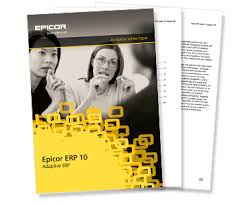Published on the 06/07/2015 | Written by Epicor Software Corporation

From their inception, Enterprise Resource Planning (ERP) systems have been deployed with an overarching purpose: reduce costs by managing processes and materials…
Until the middle 1980s, enterprise systems were built for narrowly defined business needs such as order management, account payables, and inventory control. The first real ERP systems integrated the data and processes once handled by individual programs into a single system capable of managing almost every aspect of running a sizable business. They transformed how modern businesses work. The principal benefit of a consolidated ERP strategy was ensuring that data wasn’t duplicated across departments, eliminating “islands of information.” Processes once separated could now be linked, enabling enterprise-wide planning and optimisation. For years, the focus of ERP was top-down implementation of this strategy: the imposition of processes and measurements from an executive perspective. As the marketplace has evolved into a global competition, where facilities, suppliers, and partners are dispersed geographically and supply and demand signals occur over increasingly complex and nuanced value networks, the top-down orientation of traditional ERP is proving to be less than adequate on its own. In this new business environment, change and innovation are accelerating; risk and opportunity are dynamic elements across networks, and business practices and processes are evolving at a pace heretofore unimagined. Response to this changed competitive landscape demands that ERP not only support the executive agenda but also the needs of individuals, regardless of where are they are in an organisation’s value network. Only then can companies mobilise quickly and respond effectively to events as they occur at breakneck speed, whether in Singapore or Stuttgart or the Silicon Valley. So ERP has had to evolve into adaptive ERP. Table of contents To find out more please download our free Whitepaper Epicor ERP 10: Adaptive ERP Why, when, and how to invest wisely… The benefits of incorporating a data warehouse when upgrading your ERP… What to expect for the future of payables… Manual processes can lead to error-prone data analysis… What is a Finance Department and Manager Level KPI?…
…
FURTHER READING

Financial reporting and analytics solutions

Whitepaper: Data warehouse automation and ERP

eBook: The new AP department

Whitepaper: Streamline your financial year-end close

KPIs and Metrics for Finance Departments in 2020




























